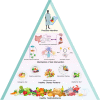Dietary patterns and cardiometabolic health: Clinical evidence and mechanism
- PMID: 36776765
- PMCID: PMC9899878
- DOI: 10.1002/mco2.212
Dietary patterns and cardiometabolic health: Clinical evidence and mechanism
Abstract
For centuries, the search for nutritional interventions to underpin cardiovascular treatment and prevention guidelines has contributed to the rapid development of the field of dietary patterns and cardiometabolic disease (CMD). Numerous studies have demonstrated that healthy dietary patterns with emphasis on food-based recommendations are the gold standard for extending lifespan and reducing the risks of CMD and mortality. Healthy dietary patterns include various permutations of energy restriction, macronutrients, and food intake patterns such as calorie restriction, intermittent fasting, Mediterranean diet, plant-based diets, etc. Early implementation of healthy dietary patterns in patients with CMD is encouraged, but an understanding of the mechanisms by which these patterns trigger cardiometabolic benefits remains incomplete. Hence, this review examined several dietary patterns that may improve cardiometabolic health, including restrictive dietary patterns, regional dietary patterns, and diets based on controlled macronutrients and food groups, summarizing cutting-edge evidence and potential mechanisms for CMD prevention and treatment. Particularly, considering individual differences in responses to dietary composition and nutritional changes in organ tissue diversity, we highlighted the critical role of individual gut microbiota in the crosstalk between diet and CMD and recommend a more precise and dynamic nutritional strategy for CMD by developing dietary patterns based on individual gut microbiota profiles.
Keywords: cardiometabolic disease; clinical evidence; dietary patterns; gut microbiota; mechanism.
© 2023 The Authors. MedComm published by Sichuan International Medical Exchange & Promotion Association (SCIMEA) and John Wiley & Sons Australia, Ltd.
Conflict of interest statement
The authors declare they have no conflicts of interest.
Figures




Similar articles
-
Dietary glycation compounds - implications for human health.Crit Rev Toxicol. 2024 Sep;54(8):485-617. doi: 10.1080/10408444.2024.2362985. Epub 2024 Aug 16. Crit Rev Toxicol. 2024. PMID: 39150724
-
A Crucial Role for Diet in the Relationship Between Gut Microbiota and Cardiometabolic Disease.Annu Rev Med. 2020 Jan 27;71:149-161. doi: 10.1146/annurev-med-062218-023720. Epub 2019 Oct 3. Annu Rev Med. 2020. PMID: 31479620 Review.
-
Dietary Patterns and Risk of Cardiovascular Disease: A Systematic Review [Internet].Alexandria (VA): USDA Nutrition Evidence Systematic Review; 2020 Jul 15. Alexandria (VA): USDA Nutrition Evidence Systematic Review; 2020 Jul 15. PMID: 35294140 Free Books & Documents. Review.
-
Dietary Patterns, Gut Microbiota Remodeling, and Cardiometabolic Disease.Metabolites. 2023 Jun 17;13(6):760. doi: 10.3390/metabo13060760. Metabolites. 2023. PMID: 37367916 Free PMC article. Review.
-
Therapeutic applications of gut microbes in cardiometabolic diseases: current state and perspectives.Appl Microbiol Biotechnol. 2024 Jan 20;108(1):156. doi: 10.1007/s00253-024-13007-7. Appl Microbiol Biotechnol. 2024. PMID: 38244075 Free PMC article. Review.
Cited by
-
Gradual Changes of the Protective Effect of Phenols in Virgin Olive Oils Subjected to Storage and Controlled Stress by Mesh Cell Incubation.J Agric Food Chem. 2023 Oct 25;71(42):15732-15744. doi: 10.1021/acs.jafc.3c04169. Epub 2023 Oct 11. J Agric Food Chem. 2023. PMID: 37820072 Free PMC article.
-
The effect of a nurse-led low carbohydrate regimen on anthropometric and laboratory parameters of patients with metabolic syndrome: a quasi-experimental study.Front Public Health. 2024 Jul 17;12:1415916. doi: 10.3389/fpubh.2024.1415916. eCollection 2024. Front Public Health. 2024. PMID: 39086815 Free PMC article.
-
Machine learning accurately predicts food exchange list and the exchangeable portion.Front Nutr. 2023 Aug 10;10:1231873. doi: 10.3389/fnut.2023.1231873. eCollection 2023. Front Nutr. 2023. PMID: 37637952 Free PMC article.
-
The Impact of a Nutritional Intervention on Glycemic Control and Cardiovascular Risk Markers in Type 2 Diabetes.Nutrients. 2024 May 1;16(9):1378. doi: 10.3390/nu16091378. Nutrients. 2024. PMID: 38732624 Free PMC article.
-
Long-Term Adherence to the Mediterranean Diet Reduces 20-Year Diabetes Incidence: The ATTICA Cohort Study (2002-2022).Metabolites. 2024 Mar 25;14(4):182. doi: 10.3390/metabo14040182. Metabolites. 2024. PMID: 38668310 Free PMC article.
References
-
- NCD Risk Factor Collaboration (NCD‐RisC) . Worldwide trends in body‐mass index, underweight, overweight, and obesity from 1975 to 2016: a pooled analysis of 2416 population‐based measurement studies in 128.9 million children, adolescents, and adults. Lancet. 2017;390(10113):2627‐2642. - PMC - PubMed
-
- Arena R, Guazzi M, Lianov L, et al. Healthy lifestyle interventions to combat noncommunicable disease—a novel nonhierarchical connectivity model for key stakeholders: a policy statement from the American Heart Association, European Society of Cardiology, European Association for Cardiovascular Prevention and Rehabilitation, and American College of Preventive Medicine. Eur Heart J. 2015;36(31):2097‐2109. - PubMed
Publication types
LinkOut - more resources
Full Text Sources
